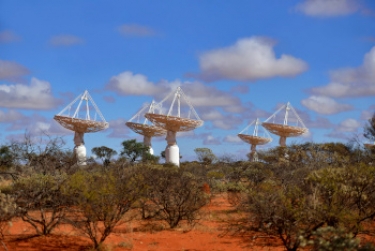A statement from the CSIRO, Australia's national science agency, said about three million galaxies were mapped in 300 hours.
The Rapid ASKAP Continuum Survey was likened to a Google map of the universe "where most of the millions of star-like points on the map are distant galaxies – about a million of which we've never seen before.It was likened".
CSIRO chief executive Dr Larry Marshall said ASKAP had brought together world-class infrastructure with scientific and engineering expertise to unlock the deepest secrets of the universe.
|
|
"It's all enabled by innovative receivers developed by CSIRO that feature phased array feed technology, which see ASKAP generate more raw data at a faster rate than Australia's entire Internet traffic.
"In a time when we have access to more data than ever before, ASKAP and the supercomputers that support it are delivering unparalleled insights and wielding the tools that will underpin our data-driven future to make life better for everybody."
Industry, Science and Technology Minister Karen Andrews described ASKAP as another example of the world-leading astronomy capability in the country.
"ASKAP is a major technological development that puts our scientists, engineers and industry in the driver's seat to lead deep space discovery for the next generation," she said. "This new survey proves that we are ready to make a giant leap forward in the field of radio astronomy."
The CSIRO said the key feature of the telescope was its wide field of view, which was generated by newly designed receivers. This offered the ability to take panoramic pictures of the sky in great detail.
The survey team used ASKAP at the CSIRO's Murchison Radio-astronomy Observatory outback Western Australia and 83% of the entire sky.
Initial results were published in the Publications of the Astronomical Society of Australia on Tuesday.
"This census of the universe will be used by astronomers around the world to explore the unknown and study everything from star formation to how galaxies and their super-massive black holes evolve and interact," said lead author and CSIRO astronomer Dr David McConnell.
The CSIRO pointed out that with ASKAP's advanced receivers, the scientists only needed to combine 903 images to form the full map of the sky, much less than the tens of thousands of images needed for earlier all-sky radio surveys.
"For the first time ASKAP has flexed its full muscles, building a map of the Universe in greater detail than ever before, and at record speed. We expect to find tens of millions of new galaxies in future surveys," Dr McConnell said.
The survey generated 13.5 exabytes of raw data that were processed using hardware and software developed by the CSIRO.
The Pawsey Supercomputing Centre's "Galaxy" supercomputer converted the data into 2D radio images containing a total of 70 billion pixels. The final 903 images and supporting information amounted to 26 terabytes of data.
Pawsey executive director Mark Stickells said the supercomputing capability was a key part of ASKAP's design.
"The Pawsey Supercomputing Centre has worked closely with CSIRO and the ASKAP team since our inception and we are proud to provide essential infrastructure that is supporting science delivering great impact," he said.
The CSIRO said survey images and catalogues would be made public through the CSIRO Data Access Portal and hosted at Pawsey.











































